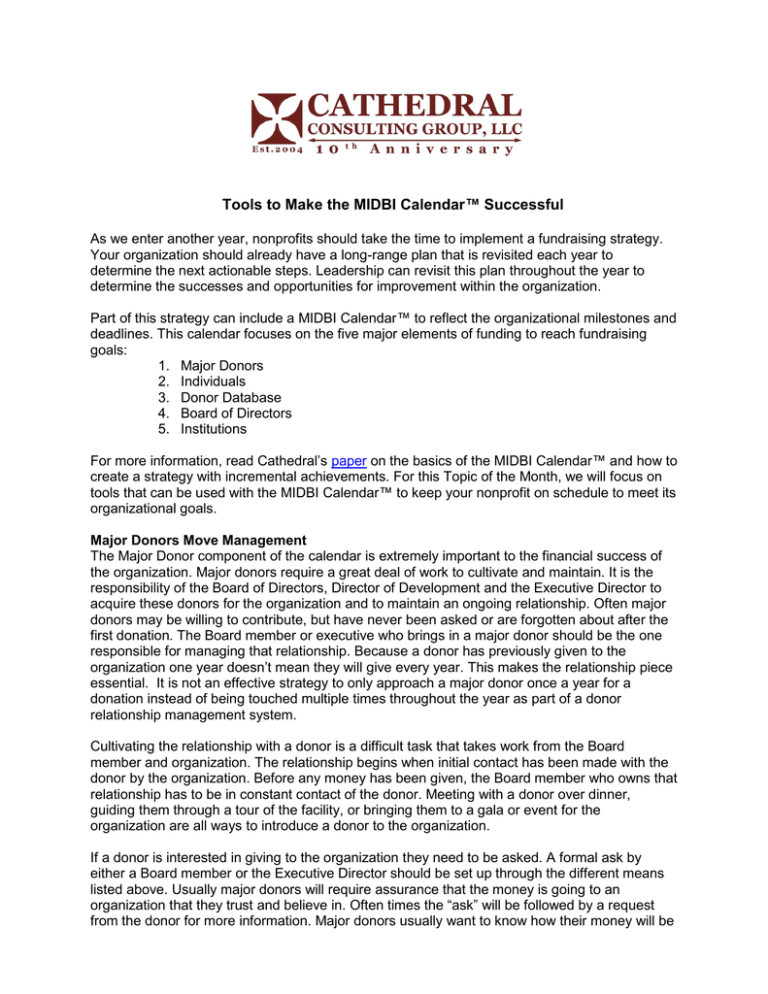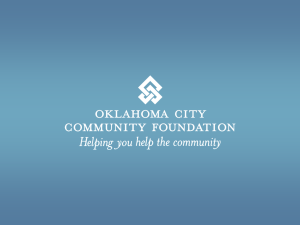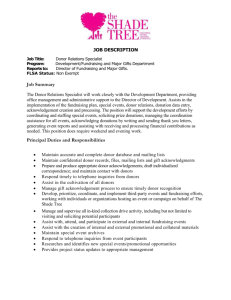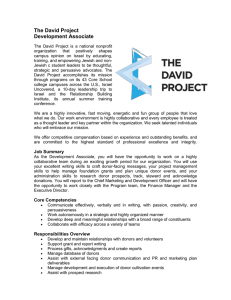the MIDBI Calendar™ Tools to Make
advertisement

Tools to Make the MIDBI Calendar™ Successful As we enter another year, nonprofits should take the time to implement a fundraising strategy. Your organization should already have a long-range plan that is revisited each year to determine the next actionable steps. Leadership can revisit this plan throughout the year to determine the successes and opportunities for improvement within the organization. Part of this strategy can include a MIDBI Calendar™ to reflect the organizational milestones and deadlines. This calendar focuses on the five major elements of funding to reach fundraising goals: 1. Major Donors 2. Individuals 3. Donor Database 4. Board of Directors 5. Institutions For more information, read Cathedral’s paper on the basics of the MIDBI Calendar™ and how to create a strategy with incremental achievements. For this Topic of the Month, we will focus on tools that can be used with the MIDBI Calendar™ to keep your nonprofit on schedule to meet its organizational goals. Major Donors Move Management The Major Donor component of the calendar is extremely important to the financial success of the organization. Major donors require a great deal of work to cultivate and maintain. It is the responsibility of the Board of Directors, Director of Development and the Executive Director to acquire these donors for the organization and to maintain an ongoing relationship. Often major donors may be willing to contribute, but have never been asked or are forgotten about after the first donation. The Board member or executive who brings in a major donor should be the one responsible for managing that relationship. Because a donor has previously given to the organization one year doesn’t mean they will give every year. This makes the relationship piece essential. It is not an effective strategy to only approach a major donor once a year for a donation instead of being touched multiple times throughout the year as part of a donor relationship management system. Cultivating the relationship with a donor is a difficult task that takes work from the Board member and organization. The relationship begins when initial contact has been made with the donor by the organization. Before any money has been given, the Board member who owns that relationship has to be in constant contact of the donor. Meeting with a donor over dinner, guiding them through a tour of the facility, or bringing them to a gala or event for the organization are all ways to introduce a donor to the organization. If a donor is interested in giving to the organization they need to be asked. A formal ask by either a Board member or the Executive Director should be set up through the different means listed above. Usually major donors will require assurance that the money is going to an organization that they trust and believe in. Often times the “ask” will be followed by a request from the donor for more information. Major donors usually want to know how their money will be used in the organization. They will want the organization to demonstrate the position of the organization and the viability it has to fulfill its mission. The cultivation of a major donor is truly a collaboration between the board member and the executives of the organization. And when the donor agrees to make a donation, it becomes the responsibility of both the relationship manager and the organization as a whole to keep up a lasting relationship. Follow up is the only way to ensure that a donor will continue to support the organization with large gifts. The donor wants to feel like their gift made a difference and that they are a valuable resource to the organization. If they feel valued, they are more likely to be a continual donor for the organization. The value is created and the relationship is best managed through a dashboard in which each donor is filed. The following dashboard outlines various details on the key elements of the relationship. This dashboard includes: Name Donation amount Relationship manager Running log of when contact is made with the donor throughout the year. This database will allow the organization to keep an account of these individuals, thus increasing the probability of an annual gift from them. This dashboard will allow the organization to track the “moves” that are made with a major donor, from a cultivation coffee to a formal ask to follow-up. Dashboard For nonprofits, one of the hardest things to plan and monitor is the fundraising efforts for the organization. In addition to utilizing the MIDBI Calendar™, leadership can implement a funding dashboard to track and monitor the funding streams coming in during the year. A dashboard should be customized to the needs of the nonprofit, but each one should have the name, type of donation, amount and relationship owner. This dashboard functions similar to a Major Donor Moves Management, except it includes all the revenue streams for the organization including foundations and intuitions. The relationship owner will oversee the donation and is the main contact for the donor. Many times this is because the relationship owner knows the major donor, has a contact in the foundation or was the person soliciting the funds. Fundraising requires endless attention and maintenance. Because a nonprofit relies on funding from outside sources, ample time should be devoted to these strategies and relationships. Just as a business spends the resources and Cathedral Consulting Group, LLC Cathedralconsulting.com | info@cathedralconsulting.com Page 2 time to bring revenue in, an organization should dedicate a similar amount of time and effort to revenue generation. The dashboard allows an organization to be efficient in their fundraising approach so that they can still have time for programming. Organizations are generally staffed with few staff and many volunteers, thus limiting the amount of time that an organization can dedicate to either programming or fundraising. The calendar can help shorten the amount of time by cataloging the pertinent information in one place. Information from prior years will also help analyze trends that may be developing with certain donors. If a donor gave a large gift last year but has not sent anything for the current year, then the organization can reach out to the individual and stay on top of contacts. The same applies for foundations. Looking at trends from previous years may shed light on what to expect for the current year, as well as what strategies were effective for contacting that particular foundation. Grant Wheel A Grant Wheel is used as an effective way to manage a grant writing effort for a nonprofit. The wheel accounts for every step in the process of grant writing. This tool documents all information and progress for each foundation. In the sample wheel below, the first step to every grant writing process is the collection of data through research. It is crucial that the information collected during this phase be documented in the wheel as a first step. The research phase will allow the writer to identify what requirements for grant consideration may be, as well as deadlines and guidelines. After the research has been done and the grant requirements align with the organization, the writer may initiate an approach. Generally, this first approach is done by a simple Letter of Interest (LOI) that is sent to the foundation. The letter highlights the organization, what grant they are seeking, along with an amount, and contact information. Cathedral Consulting Group, LLC Cathedralconsulting.com | info@cathedralconsulting.com Page 3 After the LOI has been sent, the writer must follow up with the foundations. If the foundation is interested in the organization, they will request a full proposal for consideration. The follow up process may be able instrumental in acquiring this interest. Often times, the foundation will send a letter or email to the contact and request the full proposal with requirements and deadline. This can be where the grant process ends if there is no in further interest by the foundation of the organization. If a full proposal is requested, the writer must collect all required documents and fill out an application form to submit for review. Components of a full proposal usually include: Mission, Vision and History of the Organization Program Description Program Budget List of Board of Directors Three years audited financials Organization 501c3 Determination letter and 990 Foundation Grant Application After the package has been sent, the writer again must follow up with the foundation regarding the status. This package is reviewed by a Foundation Board of Directors who distributes funds throughout the year. Some foundations will review at specific periods throughout the year that could be annually or quarterly, and some review on a rolling basis. The follow up becomes important in receiving this information on review. If the organization has been awarded a grant by the foundation, the wheel is updated with the amount and date of award. The writer then reports the grant to the Board of Directors and passes the funds to the finance committee or bookkeeper for the organization. The wheel is a continuous cycle because funds are available ever year and applications must be renewed for each fiscal year. The Grant Writing process takes vigilance and disciplined upkeep for it to be successful. For more information read our detailed paper on the Grant Wheel and how to successfully implement it in your nonprofit. Some additional things to consider when managing fundraising strategies would include: make review of the grant wheel a weekly process. Reviewing the status of every donor on a weekly basis forces the organization to be vigilant with follow ups and conscious of fundraising goals. The organization should also consider setting short term goals that help the organization reach the larger fundraising goal for the year. Short monthly or quarterly goals will help the organization’s fundraising efforts span a full year rather than once at the end of the year. Lastly, be creative with fundraising to individual donors. Events throughout the year provides the organization a time to draw supporters together and create an atmosphere for generosity and powerful messages. Galas, auctions, speaker breakfasts, or anniversary parties are all ways to fundraise to individuals at any time during the year. Conclusion It has been said “That which is monitored, tends to improve.” But there is perhaps nothing more difficult than managing a database. A deep appreciation of the importance of keeping good data must be stressed to those responsible for fundraising. It is crucial to continually update and maintain these tools or they lose their effectiveness. A good rule of thumb is to review the grant wheel once or twice a month. Larger organizations can consider hiring a full-time or parttime grant writer whose main focus is to update and push grants through the grant wheel. This practice will yield the best results. Similarly, donor relationship management is a full-time job Cathedral Consulting Group, LLC Cathedralconsulting.com | info@cathedralconsulting.com Page 4 and is extremely important for keeping major donors coming back. The use of the MIBDI calendar is valuable to any nonprofit organization for organizing the various fundraising streams. The calendar can easily be accessed by many individuals in the organization and printed for review. When the information input into the calendar is stored and tracked, the organization is able to manage fundraising and meet organizational milestones and deadlines. Additional Information 1. For additional reading on Donor Retention, read the following article: http://www.guidestar.org/rxa/news/articles/2014/donor-retention-faqs.aspx 2. For additional reading on Major Donors, read the following: http://www.guidestar.org/rxa/news/articles/2014/stay-the-course-to-raise-major-gifts.aspx 3. For additional reading on Grant Writing, read the following: http://www.guidestar.org/rxa/news/articles/2014/benchmarks-to-guide-yourgrantseeking.aspx Peter Giersch is COO of Cathedral Consulting Group, LLC and a Managing Director in the Midwest Office. Jessica Zignego is an Associate in the Midwest office. Margo Elborough is an Intern Associate in the Midwest office. For more information, please visit Cathedral Consulting Group LLC online at www.cathedralconsulting.com or contact us at info@cathedralconsulting.com. Cathedral Consulting Group, LLC Cathedralconsulting.com | info@cathedralconsulting.com Page 5






